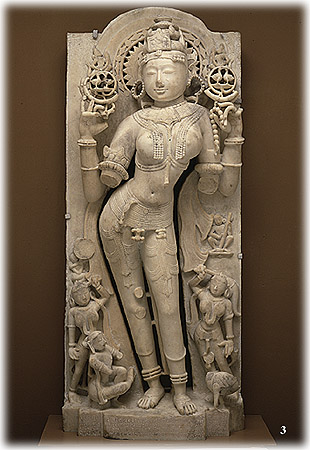

A Jain vision of Sarasvati, carved in 1153 by Jagadeva, who "aspired for fame"
Source: http://www.asia.si.edu/devi/fulldevi/deviCat3.htm
(downloaded Oct. 2005)
"Jain goddess Sarasvati. By Jagadeva (fl. 12th century). India, state of Gujarat, 1153. White marble. This image of Sarasvati, goddess of music and learning, was carved in 1153. The four-armed goddess holds stylized lotuses (symbols of purity) in both upper hands; one lower hand, now broken, would have held a manuscript, the other was probably lowered in the wish-granting gesture. The inscription on its pedestal notes that when the original image, created one hundred years earlier, suffered irreparable damage, an officer named Parashurama commissioned a sculptor named Jagadeva to create this replacement. Since few artists from ancient India are known by name, this image serves as a valuable document.
Sarasvati is venerated in several religions in India. This image was created for a temple of the Jains, a faith that originated in the fifth century B.C. The exquisite goddess, approachable by all who seek knowledge and musical skill, is testimony to the skill of the otherwise unknown sculptor Jadadeva, who, in the words of the inscription, 'aspired for fame.'"
== Indian Routes index == Indian Routes sitemap == Glossary == FWP's main page ==